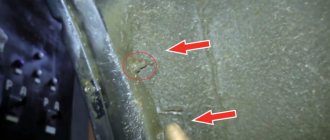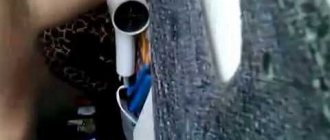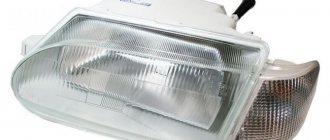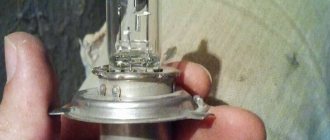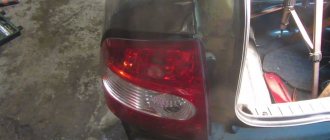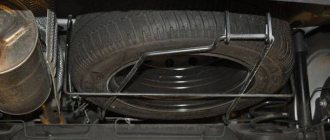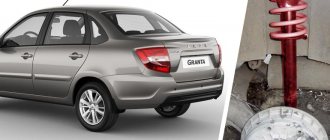08 August 2017 Lada.Online 21 992 2
The front and rear suspensions of Lada XRAY and Largus are equipped with telescopic hydraulic gas-filled shock absorbers. During operation they have to be replaced with new ones. The process of replacing them with XRAY and Largus is similar, because both cars are produced on the same B0 production line.
Attention.
Suspension shock absorbers should be replaced as a set for both sides. Replacing the shock absorber on one side is not allowed.
Body - local corrosion
The little thing that AVTOVAZ made with its own hands is the radiator grille. And there are examples when it melted from the heat from the engine compartment. Otherwise, the “casket” is lucky: it is assembled on a specially built B0 line, certified to Renault-Nissan standards, including stamping outer body panels from galvanized sheets, but not all.
We carefully look at the edge of the roof above the windshield, then at the doors: corrosion often spreads from the interior side. Of course, on the sills and the bottom - they are constantly being peeled off, crawling over potholes.
The spare tire is suspended under the floor of the rear overhang of the body. The decision is controversial, because the disc becomes covered with rust after just a couple of seasons, and the hanging basket in which the fifth wheel lies turns sour in just one winter. Do not forget to lubricate the mechanism every spring and autumn, or hang the spare wheel on the back door, as many owners do. True, the rear flap doesn’t need an extra ten kilograms either.
Electrics are a weak point
With daily use, headlights wear out within two to three years. There is no point in doing restoration: old optics cannot be saved, and new ones will cost the price of polishing. The same two or three years are given to the wiring that is laid from the body pillars inside the rear hinged doors - the wires simply break.
The sound signal is located on the steering column lever. And the levers themselves are of poor quality: because of this, the first speed wipers chronically do not work on many cars. The electrical equipment is made from the cheapest components. Therefore, there were, are and will be problems.
Analogs of rear shock absorbers
As for analogues of largus. We do not have exact data (sizes). Therefore, we will not mislead you. But, we authoritatively declare that on the spare parts market you can choose the necessary goods from global manufacturers and products from Russian companies. Here are some of them:
- The products of the manufacturer Monroe are of interest. You can order directly and save money.
- Sachs products are considered softer.
- Among the domestic manufacturers, one can single out the Russian one, which produces several lines. The “Comfort” kit has won the greatest popularity among Largus owners. They have an acceptable price/quality ratio. Many people like the kit, although they complain about excessive rigidity. The best absorption of road surface irregularities occurs at a speed of 50 km/h.
Accelerating car - sure signs
Largus, for obvious reasons, is loved by shuttle workers and builders who take the car for slaughter, and after driving two or three hundred thousand, they throw it away, reducing the mileage. Therefore, carefully look at the condition of the roof rails and trunk lining - these details will certainly hint at who the previous owner was. Another warning sign is the presence of a towbar.
And only the installed gas system is an ambiguous sign of an accelerating car. As the mechanics of one club service told us, Largus buyers are practical people, so they supply propane and butane through one person. But methane kits are usually ordered by legal entities for corporate vans and station wagons. AVTOVAZ itself even makes a factory version that runs on methane, but it’s more of an exotic thing that comes in a van.
Lada Largus and Lada Largus Cross
Summarize. If you want a little better ride and comfort, or if you need to regularly wade through fields and small bushes without damaging the body, take the Largus Cross. If every penny counts, a station wagon will do - it’s both cheaper and a little more economical to operate. By the way, Largus without the Cross prefix is also available with an eight-valve engine that can be fed with 92-octane gasoline. But the 102-horsepower sixteen-valve engine installed on the test cars is designed for 95-octane gasoline.
Renault engines are strong hardware
At first, French eight- (K7M) and sixteen-valve (K4M) 1.6 engines were installed on Largus. These units, known from Logans and Sanderos, are famous for their service life of about 400,000 km. If the engine falls apart before the car, it is easier and cheaper to buy a contract unit. It’s realistic to buy it for 50–60 thousand rubles, but for a proper overhaul they’re now asking around a hundred. And it’s not a fact that they will do it well.
We will disappoint those who like to install everything new. For K4M, sellers want as much as 300 thousand rubles, and this is without attachments. At the same time, a brand new cylinder block is sold for 15,000 rubles, and a head for 50,000 rubles. If you decide to overhaul, buy plug-in pistons that do not interfere with the valves if the timing belt breaks. In the eight-valve model, the belt lasts 60,000 km, and in the older version - 120,000 km. We also recommend investing in rollers and a cooling system pump.
The eight-valve engine suffers from oil leakage through the front crankshaft oil seal - keep an eye on the level on the dipstick. Every hundred thousand, the valves need to be adjusted - here the French saved on hydraulic compensators. Although the sixteen-valve engine has hydraulic cups.
With age, the ignition coil insulators dry out, and the crankcase ventilation system becomes overgrown with dirt. To prevent lubricant from starting to flow through the receiver, the system must be cleaned. A tiny air filter becomes clogged with dust after 8–10 thousand km, after which the car stops driving. You can ignore the squeaking of the suspension belt rollers - this is more of a proprietary feature than a malfunction, just like the ever-leaking valve cover.
Replacing shock absorbing struts
It is necessary to change the Lada Largus shock absorber when a factory defect is detected or when a certain mileage has been covered. Unscheduled work is carried out in the presence of obvious defects or leakage of technical fluid. And also, in case of loss of their performance.
On a note! Replacement of a failed set must be carried out in pairs.
Carrying out technical work is preceded by diagnostics, and the tightening of the bolts securing the shock absorbers to the levers is also checked.
Removing shock absorber struts
Let's find out the algorithm for dismantling actions:
- The vehicle must be placed on a lift. It is possible to carry out dismantling activities in the inspection pit. In this case, you need to put the car in first gear and put stops under the front wheels.
- If the car is designed for 5 passengers, as is the case with the R90 model, you need to move the lining of the rear wheel arches to the side. Having opened the luggage compartment door, we remove the rear seats of the third row, if we are talking about a station wagon.
- Remove the trim from the rear arches and remove the lower mounting bolts. Remove the trim frame.
- Remove the rubber cap from the shock absorber.
- Next, you can see the nut that holds the rod. She is also being filmed.
- Then the rubber cushion is removed.
- The fastening bolts are removed.
- The shock absorber is removed.
Please note that there is a rubber cushion, a washer and a spacer sleeve on the rod: the elements must be removed
- The compression buffer and protection cover are removed from the rod.
- They must subsequently be separated.
- The protective cap is dismantled.
- If there are worn out and/or damaged parts, remove them.
After this, the shock absorber is placed vertically. The rod lowers and extends until it stops. In this case, there should be no extraneous noise, knocking or failure.
If the above points occur, the shock-absorbing structure changes. It is also dismantled if deformation of the rod is detected and/or the integrity of the threaded connection is compromised
When checking, pay attention to the degree of compression of the spring
Similar to the procedure described, the second shock-absorbing device is dismantled and replaced.
It remains to consider the issue of installing a new kit, which is what we will do.
Shock absorber installation
Installation of the rear shock-absorbing structure is carried out in reverse order.
Note! If the boot and bumper have become unusable, you need to change them. So, as we have already said, installation is carried out in the reverse order:
So, as we have already said, installation is carried out in the reverse order:
- You need to install a new nut that secures the shock absorber rod.
- It is advisable to change the shock absorber mounting bolt connecting it to the rear suspension.
- The following is placed on the rod: a washer, a hinge bushing, and a lower cushion.
- We install the shock absorber in the rear wheel arch of the car.
- We connect it to the lever of the rear suspension structure.
- The rod fits into the mounting hole of the wheel arch.
- The upper hinge pad, control washer and new fastening nut are put on the rod. The tightening torque of the nut is 14 Nm (1.4 kgf.m).
It is important not to tighten the fastening bolt all the way. We work with a replaceable head No. 21, a knob
Don't forget to put the plugs where the new elements are attached to the rear wheel arches.
The above operations in the specified sequence are acceptable for working with the second shock-absorbing structure.
We put the wheels in place. We fasten the arch trim, storage compartment, fastening parts and brackets for the side and rear armrests.
We lower the car to the ground. And only now we tighten the bolts securing the shock absorbers to the arms of the rear suspension structure.
The tightening torque of the bolts is 105 Nm (10.5 kgf.m. We work with a replaceable head No. 21.
VAZ engines are less reliable
Since the end of 2015, the 87-horsepower VAZ eight-valve 1.6 (VAZ-11189) has been installed on Largus. It is a little more powerful, more torquey and more economical. The resource reaches a quarter of a million kilometers. But there are just small jambs behind the VAZ engine - apparently and invisible! Moreover, it will not be possible to sort all the disadvantages into categories - each collected copy is individual.
Only a large loss of oil in the first thousand kilometers is a common feature. Then, as soon as the parts are broken in, the oil burn will go away and fuel consumption will become less.
The biggest problem with VAZ engines is poor-quality belts. Therefore, be sure to inspect the drive at a mileage of 60,000 km, although the manufacturer, according to regulations, recommends driving up to 75,000 km. Since 2022, AVTOVAZ has introduced “stickless” pistons - belt breakage is no longer so scary.
It is recommended to check the valve mechanism running clearances every 45,000 km, but in practice adjustments have to be done more often. You can, of course, ignore this procedure, but then don’t be surprised by untimely burnt valves. On the contrary, leaking gaskets should be treated philosophically.
In 2022, a similar replacement took place with 16-valve engines: VAZ-21129 began to be installed instead of Renault engines. In terms of reliability, it does not differ from the “eight-valve” one, but has hydraulic compensators. And they love clean and fresh oil; they knock on dirty oil even on new engines. Feel free and radically reduce the intervals between maintenance.
How does the Cross version differ from the regular one?
The prefix “cross” to a model name almost always means an artificially created illusion of a crossover. In the case of the Largus, these are unpainted bumpers and plastic linings on the arches and sills, so as not to scratch the most vulnerable parts of the body on dirt roads. The regular Largus is equipped with 15-inch wheels, while the Largus Cross is equipped with 16-inch wheels. The ground clearance of the cross version is 210 mm, while on the regular Largus it is 185 mm.
Car interiors are almost no different from each other. In the cross version, the seats are decorated with oblique stitching, and the dashboard is made of two colors.
For the cross version, the engineers even changed the suspension slightly: the shock absorber body and rear springs are longer. This allows you to feel more comfortable when driving on bad roads than on a regular Largus.
At the same time, Largus Cross spends 1.5 liters of gasoline more than a regular station wagon: 11.5 liters versus 10 liters per 100 km!
Gearboxes - manual only
The French eight-valve engine will be paired with a 5-speed manual JH3. It does not tolerate tight driving when the driver engages fifth gear almost at idle. This manner overloads the input shaft bearing-oil seal and the unit can howl after 70,000 km. Use only the original bearing as a replacement: analogues last three times less.
The inner boot of the left drive also plays the role of a gearbox seal. And after a while oil begins to leak from here. If you miss the moment, the transmission will be left without lubrication at all. Therefore, urgently buy a repair kit and three liters of transmission.
With the departure of the eight-valve K7M, there was only one box left - JR5. It is even more reliable, but both units have a unit that combines the working cylinder and the clutch release bearing. It usually has to be changed after 50,000 km. Installation requires skilled hands, otherwise there is a chance of breaking off the fragile pipe under the hydraulic line.
Another common problem is the frankly short fifth gear, which can lead to excessive consumption of gasoline. If you wish, you can correct this miscalculation by replacing a pair of gears, and skilled craftsmen will perform the operation without removing the box.
The resource of the French “five-step” is about a quarter of a million kilometers. But under one important condition: the transmission should be changed every 60,000 km.
Since 2022, AVTOVAZ has introduced its own mechanics under the index 2180. The gearbox works even more clearly than the French ones, and everything is not bad with reliability. But the owners also complain about them: one has difficulty engaging reverse gear, another is bothered by noise, and the third cannot overcome leaks.
Suspension - the standard of reliability
In this car, only the suspension works flawlessly. Even stabilizer struts and bushings last up to 100,000 km, and a major overhaul of the chassis is unlikely to take place before 150,000 km.
Prices for spare parts are a gift! The original front suspension arm costs only 3,000 rubles. And this is with silent blocks and a ball. There are two types of ball bearings: if you decide to upgrade a three-hundred-ruble bearing separately, consider in advance which one is suitable for your car.
According to factory requirements, the rear wheel bearing must be replaced with the brake drum. It costs about 15,000 rubles. Although everyone has long known that you can take and press a bearing separately. As practice shows, the drum is enough for one bearing replacement. The second time it is better to change the assembled part - the seat in the drum is broken.
The Largus is equipped with a power steering rack. If the mechanism is knocking or leaking, the mileage has probably exceeded a couple of hundred thousand. There is no point in spending money on a refurbishment - a new non-original one costs less than 20,000 rubles.
Stabilizer bushing for Renault Logan: basic information
The stabilizer tube on the Logan sedan is attached to the subframe. Well, in order to remove the bracket, you need to unscrew two parts: an 18mm screw and a nut (see photo). A 10mm wrench is suitable for the nut.
There are a couple more tricks:
- The surface of the stabilizer at the point of contact with the bushing will need to be wiped;
- The new bushing is first cleaned of protective oil. Then it is lubricated from the inside with silicone grease (any);
- To unscrew the nut, you need an open-end or socket wrench. The screw can be unscrewed with a spanner or socket wrench.
There is a mistake: often after installing the bushing, the bracket does not close completely, and then the screw is simply tightened harder. And you need to support the bracket from below. A jack is used for this (see photo).
The car itself may be on the asphalt, and one of the sides is jacked up.
On a car like Renault Logan, replacing stabilizer bushings looks simple. But any mistake entails the most negative consequences. Don't overestimate your strength!
I’m buying Largus - which one should I choose?
Take a car with a brand new 16-valve K4M engine - it’s peppy and predictable. Consumption, however, is high, but this problem is partially solved by a small upgrade of the gearbox. And hurry up with your purchase! Such cars have not been made for three years.
This Lada Largus, as well as many other proven used cars, can be purchased from Automama
.
- When planning to ride off-road, it is always better to put chains on your wheels in advance. If the need for chains is not obvious, make sure you have bracelets. Antibuks will also come in handy!
Few people know about car accessories that don’t cost a lot of money and bring real benefits! We recommend taking a look at the windshield drain, hood and trunk struts, and radiator guards. Their installation is simple, the benefits are undeniable!
Lada Largus and Lada Largus Cross
We meet by clothes
There are not many external differences between the Largus. And only by looking closely, you can determine that the cross-version is slightly taller than the donor. It has unpainted bumpers with gray inserts on the lower part, as well as additional black trim on the wheel arches and sills. The regular Largus is equipped with 15-inch wheels, while the Crosses are equipped with 16-inch wheels. The only thing is that both have the same spare wheel, 15 inches, so in the first case the spare wheel is full-size, and in the second it is only in stock status. We have both cars in the maximum configuration: Largus Cross in the Luxe version, and the regular Largus - Luxe Prestige. Actually, the Prestige prefix only means cast wheels instead of stamped ones. But the cross modification has alloy wheels installed by default.
Shock absorbers from Largus van
Shock absorbers from Largus van
ropblHbl4 » Jun 22, 2015 3:15 pm
Re: Shock absorbers from Largus van
ropblHbl4 » Jul 06, 2015, 10:46 am
Re: Shock absorbers from Largus van
romka. » 06 Jul 2015, 13:54
Re: Shock absorbers from Largus van
dimone73 » Jul 06, 2015, 2:17 pm
Re: Shock absorbers from Largus van
ropblHbl4 » Jul 07, 2015, 11:44 am
Re: Shock absorbers from Largus van
ropblHbl4 » Jul 07, 2015, 11:45 am
Re: Shock absorbers from Largus van
dimone73 » Jul 07, 2015, 07:46 pm
Well get ready. Now I will give you a lecture on mathematics and the design of cars. And if I lie, I hope my technically savvy comrades will correct me and support me. So. The wheelbase (in transport - the longitudinal distance between the axles of the front and rear wheels) of Logan is 2630 mm. According to the owner of the new tuning, the rear has now risen by 2 centimeters, or 20 mm. Imagine that in the picture there is a car that drives from right to left. And the base of the car is the distance OA. I remind you from the school geometry course that the tangent of the angle alpha is the ratio to (the ratio of the opposite side to the adjacent side). Now, instead of OA, it’s the base, and instead of AB, sorry, your raised ass. We calculate the ratio of this same AB to OA. We get 20/2630=0.0076 and now we know the tangent value. And knowing it, you can calculate the angle. Let me remind you that this is a reciprocal trigonometric quantity. The arctangent of a number a, where a is any real number, is the angle alpha from the interval (??/2, ?/2) (or from ?90 to 90 degrees not inclusive), the tangent of which is equal to a. Knowing the tangent, we calculate the angle using any engineering calculator. It will be equal to 0.4357 degrees, or more precisely in angular minutes 26.14′ I remind you of such an automobile phenomenon as Castor (from the English caster angle or castor angle) - the angle of longitudinal inclination of the axis of rotation of a car wheel. Castor is measured in degrees and is the angle in the longitudinal plane of the car between a vertical line and a line passing through the centers of rotation of the wheel.
Again, the picture shows a wheel from a car that moves from right to left. Castor affects the stabilizing moment and the change in wheel camber when turning the steering wheel. The larger the castor, the greater the stabilizing effect when the wheels are turned out. Due to the fact that the point of contact of the wheel (with positive castor) with the surface lies somewhat behind the turning axis, when the wheel deviates from straight-line motion, lateral forces arise, tending to return the wheel to its initial position. That is, after a turn, at the exit from it, if you drop the steering wheel, the car will straighten the direction of movement. In addition, if at the initial moment of deviation of the wheels from the neutral position when cornering, only the outer wheel has the necessary negative camber, then as the deviation of the wheels towards the turn increases, the outer wheel acquires even greater negative camber, and the negative camber of the inner wheel decreases or even becomes positive . Thus, castor has a beneficial effect on the grip of the steered wheels in corners. If the castor is normal, then you can move in a straight line simply by releasing the steering wheel. And if the castor is not normal, then the car will have to be steered all the time. Due to the machinations of the imperialists, some cars, in particular the Logan, do not have structural adjustments for caster and camber. That is, by raising your butt, you reduced the castor by approximately 26.14′ I hope this is clear? Next point. “Sorcerer”, or, according to the catalogue, a pressure regulator in the brake drive, which has received such an apt nickname among the people for good reason: no one really knows how it works, but, they say, being faulty, it can present an unpleasant surprise - make the car dance when emergency braking. This is where the insidiousness of the “sorcerer” lies: during normal operation, without braking to the floor, its work or inaction is practically not felt, but when its help is especially needed, it may not come. The optimal adjustment of the “sorcerer” according to the recommendations of the CPSU, the All-Russian Central Council of Trade Unions and the Central Committee of the Komsomol magazine “Behind the wheel” corresponds to the average factory settings, and a few percent can be gained only with individual correction for specific brake pads, tires, vehicle loading and road conditions. But it’s unlikely that anyone will start every trip with a test run.
Installation of wheels with a larger radius
Largus comes standard with 15R wheels. Many motorists choose the 16 or 17 radius option instead of the one proposed by the factory. Additionally, this makes the car's exterior more attractive. However, this option also has a significant drawback, namely the unstable position of the car when driving, as well as malfunctions in the ABS system and some related sensors.
Installation of spacers
The most budget option (and popular) is to install special spacers, which are sold at any auto parts store. The only thing that is required from the car owner is the removal of the suspension struts. The parts themselves are unified and suitable for many VAZ cars. Spacers are installed between the rack and the body bowls (as an option - between the beam and the rack).
Replacing strut parts
One of the best methods for increasing ground clearance is to install stiffer springs and longer shock absorbers. As a rule, such racks are approximately 20 mm longer than standard devices. In combination with reinforced springs, they are able to significantly increase ground clearance, and the car does not sag all the way when transporting the maximum permissible weight of cargo. The only drawback is the higher price of such kits.
- Lada Largus car data
- Tips for installing and operating roof rails on Largus
- Universal and original DRLs for Lada Largus
- Methods for attaching a spare tire on Largus
- The principle of operation of LPG on the Lada Largus: which gas is better?
- Alternator belt Lada Largus - types and replacement on different types of engines
Front struts SS20 for LADA Largus, stiffness Comfort Optima (SS20.565.10.000-02) SS20342
The struts and shock absorbers on the Lada Largus from SS20 are superior to analogues and factory struts in terms of comfort in passing small holes and unevenness, due to a specially designed floating piston.
Struts and shock absorbers for LADA Largus
Front struts for LADA Largus are superior to the standard Largus suspension in terms of reliability and comfort. In the manufacture of shock absorber struts for the Lada Largus, the latest SS20 developments were used to modernize and improve performance. The racks of the Lada Largus from SS20 are made with reinforcement of the main parts, and allow you not to lose control comfort even at high speeds. Shock absorbers SSS20 for Lada Largus are suitable for all versions of the car, 5-7 seater and cargo vans.
Applicability
- Front shock absorbers for 5 and 7 seater and cargo LADA Largus (OEM 543024989R, 543027245R)
Main differences and characteristics of front shock absorber struts and rear shock absorbers SS20 for LADA Largus
- The struts and shock absorbers on the Lada Largus from SS20 are superior to analogues and factory struts in terms of comfort in passing small holes and irregularities, due to a specially designed floating piston;
- Highest stability and resistance to swaying in corners and on uneven roads;
- Manufactured in an enlarged glass, which allows to increase the service life and completely eliminate overheating on dirt roads;
- The service life under standard operating conditions in Russia has been increased to 7–8 years due to a complex of reinforcements, enlarged housing, breakdown protection, soft damping of valves and double protection of oil seals;
- A special difference between the SS20 struts and shock absorbers is the paired selection of sets according to the level of rigidity, which ensures perfectly synchronized operation of the suspension;
- As has already become a standard, SS20 offers a choice of 4 types of rigidity levels: “Standard”, “Comfort-Optima”, “Highway” and “Sport”. And in our online store we keep in stock the most popular hardness types among car enthusiasts, Highway and Comfort.
Description
The most important characteristic of the SS20 struts for the Lada Largus is the significantly reinforced rear shock absorbers, since the Lada Largus is a car designed for increased specific cargo loads, transportation of passengers and cargo.
Lada Largus struts and shock absorbers offer four damping options: “Standard”, “Comfort-Optima”, “Highway”, “Sport”. And each owner of Lada Largus can choose the comfort level they need or with a reserve for cargo transportation. “ Standard ” - the softest shock absorbers in terms of settings, an excellent solution for those who prefer a soft suspension, a smooth ride, and quiet movement. This shock absorber setting is suitable for everyday use, mainly in city conditions.
- “ Comfort ” is a solution for most Lada Largus owners; rigidity is slightly increased compared to standard struts, which allows you to feel more confident behind the wheel in any conditions and load. Essentially the golden mean between comfort and handling.
- “ Highway ” is the most excellent choice, which allows you to drive at high speeds with a high degree of controllability, the absence of rolls and nods, and also maintain properties when transporting passengers and cargo, while maintaining a normal level of comfort.
- “ Sport ” - highly rigid shock absorbers and struts are designed for extreme driving conditions, ideal handling in corners at any speed. Recommended for middle class racing in various disciplines without the need to lower the car or reduce the ground clearance.
SS20 shock absorbers on Largus are the main advantages of the design.
- The kit includes shortened polyurethane foam compression stroke buffers, which are installed instead of the standard rubber ones and allow you to increase comfort on an empty machine and with a partial load, and are also more elastic in the cold and warm up to operating temperature faster than the standard rubber ones.
- Large selection of different levels of hardness;
- Significantly reinforced design of the main components;
- Increased diameters of the rear rod and shock absorber piston, and increased service life;
- Due to the enlarged shock absorber glass, there is a larger amount of oil - which also increases the shelf life of its properties and also protects against boiling on the primer;
- Complete with reinforced rear shock absorbers, boots and bump stops are included.
Warranty and suspension are like new.
Lada Largus Cross 2015
Well, yesterday they called and informed us that the levers had arrived, left and right, because according to Lada’s instructions, the ball joints cannot be changed separately (they are all part of the lever) and one at a time, so the engineer ordered both.
The levers, as it turned out, are suitable for Renault Logan, regular Largus, Sandero and a bunch of Renault cars. The difference between the crosses is the higher mounting of the strut and shock absorbers, springs, i.e. They won't run from Renault anymore..
“..Largus with the Cross prefix has original front struts. In particular, the spring cup is welded to the body 30 mm higher than that of the station wagon. This also ensures increased ground clearance. By the way, both models are equipped with Monroe struts from the factory. The rear gas-filled Monroe shock absorbers are also different. This is confirmed by identification numbers. The housings and shock absorber rods of the Largus Cross are longer, and the length of the rear suspension springs has also been increased...”
In the existential version, the original Renault Lada lever costs 2,650 rubles
Front left suspension arm 28 pcs. 17 days
Replacements for a lever from a third-party manufacturer cost 1200 and change
CAT002 Front left lever 100 pcs.
The ball itself - from 320 rubles
PN-010 Ball joint (set) 100 pcs. 15 days
As the warranty manager said, he himself was surprised that the ball joints died so early (22,000 km) (the right one was already rattling, the left one was creaking in the potholes, and the steering wheel began to pull slightly to the right
), he says, of course, a lot depends on the driving style, to which I replied that the simplest thing is 2 years on asphalt and a couple of times a month at the lake for two seasons. He says that “there may be a defect in a specific batch, because this year he ordered levers for only four citizens.” When asked if it was crosses, he found it difficult, because he didn’t care
In any case, the warranty on the ball joint from VAZ costs 3 years or 50,000 km, whichever comes first. They changed it silently.
But I got brand new levers with new ball joints and a couple of new bushings in each.. I drove it after the service - it felt good, it stood tightly on the road, as if it was the first time I left the store, monolithic and elastic.
In any case, even if these last, let’s say, 22-25k, spend 5-6 thousand on new levers and the ride will be rough again - and to hell with it.
On Western forums they write that the levers of crosses die faster due to the greater travel of the strut or...
I'll take a look, because on the Lada Largus forum dot com there are citizens who drove factory ball joints from 80,000 and above..
PS: in the photo with the stand - my know-how, sort of. So that the plastic casing that is put on the spring does not come off, they grab it anyway, but I just grabbed them with wires, because this is a problem with Logans - this casing (or whatever it is called) comes off and the spring will rub against the cup on top spring and creak..
The dealer said that this is not a malfunction and that he should be screwed, do as you wish, it does not affect the operation of the rack.
After replacing the levers, they did not check the wheel angles and toe-in; they said that they do not change when changing the levers and according to the service instructions this is not allowed.
In any case, the steering wheel was straight and precise, which means they know better.
In terms of other parameters, the mechanic from below looked at it with a flashlight, shook the wheels, and says everything is in excellent condition. The front pads and discs still last at least the same amount of time...
They’ll look at TO-2 to see if it’s worth changing the spark plugs (since they don’t have thirty miles) and that’s it, I moved on..



